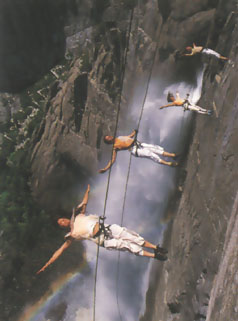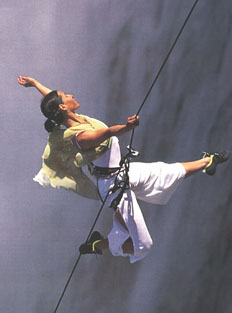|
Saturday August 19, 2001
Climbing At Yosemite
Isn't What It Used To Be!
With
nylon ropes & steely nerves Project Bandaloop
performs Yosemite Falls ballet high above Merced River.
Compiled by Amy Williams, Staff Research
 YOSEMITE
VALLEY -- Unlike most conventional choreography and
dance, the Bandaloop Project that recently visited
Yosemite
avoids an on-site public audience. YOSEMITE
VALLEY -- Unlike most conventional choreography and
dance, the Bandaloop Project that recently visited
Yosemite
avoids an on-site public audience.
Though some may venture out to watch
the performance live, this is art made in the vast silence of
the wilderness.
It is a performance without traditional trappings.
The performers do not know the "script" of the action
before they set out.
The site-specific nature of the dance
and the story of the event will unfold during the process.
Project Bandaloop is committed
to respecting the wilderness and will adhere to low impact ethics.
In ten years of performances, we have only once placed bolts once
to rig a dance (hand drilled, within park regulation and removed
afterwards).
The circumstances of that rig were complex
and unfortunately we made a decision, out of line with our traditional
ethic, that received the biggest press to date.
No bolts are used to rig the dances for
this mountaineering and dance project, that traverses the
Sierra Nevada. In the mountain segment, Project Bandaloop,
works together as a group to make dances over 20 days in the Yosemite
mountains while crossing the Sierra.
Along the route the performer-mountaineers
create site-specific dances in the form of scored improvisation
and choreography on the ground and on the rock faces. Conceptually,
the piece explores crossing from one state of being into another,
from one water shed to another.
The daily mindset of urban culture is
left behind and the cast is asked to create and perform in the
isolation of mountain spaces.
Initiated as a proposed performance piece
for the summer of 2000 with an application for funding to the Creative Capital in 1999, the project has now become a
reality in the summer of 2001.
Creative Capital in 1999, the project has now become a
reality in the summer of 2001.
The piece has also grown into a three
year project with further funding from the James Irvine Foundation
that is for creating an urban multi media dance piece based on
the mountain traverse that will premiere at urban performance
sites in 2002-2003.
The project requires a variety of skills
including but not limited to low impact travel through
the mountains, dancing, climbing, rigging, logistics, videography,
composing and playing music and carrying gear.
Making dances in this context, the cast
is inspired and challenged. The physical, topographical, interpersonal,
and meteorological challenges are outweighed by the landscapes
and light offered by these mountains.
They approach this project with a strong
sense of teamwork and climbing skills essential to orchestrating
the scope of the technical and artistic capabilities of the group.
The choreographer draws
from the imagery of the landscape and from
animals that live along the route. The performance utilizes various
aspects of the landscape from horizontal valleys and ridges to
vertical faces of boulders and grand vertical sweeps of cliffs
to inspire movement.
The details of the choreography draw
on the techniques they have developed over the last ten years
using ropes, harnesses and anchors to allow for the vertical plane
to become a dance floor.
The natural movement such as wind, rain,
the fall of gravity, the jutting of rock, the flow of a river
and stillness of a boulder evoke movement and expression of ideas.
Animals such as marmots, coyote, small
birds, falcons, bear and mice are other sources of movement design
and conception. Observations of the environment and its inhabitants
allow for the co-existence of the dance, the dancers, the animals
and the land.
The climbing route becomes a "stage"
for a dance that exists throughout the project, unifying the process
with the performance.
Stillness is as
important to this project as all the effort and movement.
[Editor's
Note: Project Bandaloop dancers, climbers and riggers are
under the artistic direction of Amelia Rudolph, and collaborate
to create a blend of dance, sport, ritual, and environmental awareness.
Exploring the boundaries of dance and performance, their work seeks
to honor nature, community, and the human spirit through art. Inspired
by the possibilities of climbing and repelling, the choreography
relies on aerial, vertical and horizontal movement to craft site-specific
dances. The challenge of performing in a wide variety of
venues, ranging from urban towers and skyscrapers to boulder fields
and large granite cliffs, helps free both the dance and dance space
from convention. The groupıs work marries modern
dance and rock climbing, culture and nature, mortality and celebration.
Project Bandaloop hopes to enrich the quality of life and educate
the public by stimulating viewersı awareness of their natural and
built environments, and by reaching out through free appearances
to new audiences unfamiliar with contemporary dance forms. For more
information click on the Bandaloop
Project or see The Smithsonan Magazine, Vol 31.No. 6. pp.
87-92.]
Letter
to the Editor

|







